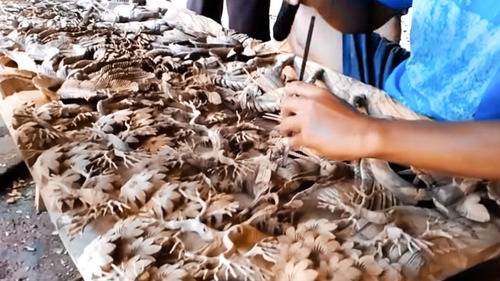Furniture And Wood Carving Craft in Java Indonesia – Carving is a branch of fine art whose manufacturing process is by reducing the portions with a predetermined pattern or image tied to the cultural patterns of the community concerned. The existence of carving art that lives and develops in Javanese society is a cultural product that contains high values. These cultural products include a variety of diversity that is influenced by the value system adopted by which the artifact was created.
Java, as well, has a productive wood carving convention, with furniture, design, toys, and theater gear all being extravagantly decorated. In Cirebon on the north coast, the angling vessels have cut poles and insides. The royal residences of Kasepuhan and Kanoman have delightfully cut engineering components, as do the illustrious carriages. Court exhibitions witness a showcase of cut veils and melodic instruments.
Central Java has a long history of wood-making, not just in the generation of vessels in the sixteenth and seventeenth hundreds of years; however, later under the direction of the women’s activist reformer R.A. Kartini, the woodworkers, and carvers were urged to deliver items for a fare to Holland. A significant part of the work was done at Jepara, which built up a western-affected style of cutting on the furnishings. All the more as of late, Mrs. Tien Soeharto utilized Jepara carvings in the Presidential Palace with the expectation that global guests would investigate Indonesian craftsmanship. Today Jepara carvings, many highlighting scenes from the Ramayana and Mahabharta, or scenes from day by day life, have discovered support with purchasers abroad.
Skilled workers, for example, Suhud, situated in Sukodono in Jepara, have argued that artisans be inventive. He has built up a fabulous style of furniture that is exceptionally etched and structured as a focal inside element. Utilizing the cockleshell as his motivation, his drive has discovered support with a scope of purchasers.
Kudus is well known for its intricately cut inside allotments (gebyok), the style regularly being compared to the delicacy of hair. A large number of the carvings are of adapted plants and vegetables that are viewed as speaking to the flourishing of the previous Kingdom of Demak. These highlights are utilized today in the style of inn entryways, social focuses, exhibitions, and homes. In the illustrious city of Yogyakarta, probably the most intricate and resplendent woodcarvings might be found. Regardless of whether furniture, space dividers, litters, wedding beds, melodic instruments, or structural highlights, ravishing, overlaid cutting flourishes. The covers or pole manikins (golek) are likewise artful culminations of the carvers’ aptitudes, and a few people have practical experience in cutting the handles and different components of the kris.
The royal residence at Yogyakarta is a tribute to the specialty of woodcarving. A wide range of trimmings – for the most part with representative importance – decorate the design, furniture, and real treasures. Instances of the cut components incorporate the garuda and the naga, which symbolize the sky and earth. A large number of the cut items have significant custom importance and must be wholly comprehended in this unique circumstance.
Yogyakarta flaunts various expressions organizations, and a considerable lot of these are effectively occupied with creating woodcraft. The towns of Serenan, Klaten, and Surakarta are likewise perceived as primary specialty focuses, frequently fusing the art into contemporary inside structure and engineering. Furniture And Wood Carving Craft in Java Indonesia


